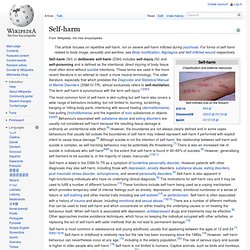

Suicide. The most commonly used method of suicide varies by country and is partly related to availability.

Common methods include: hanging, pesticide poisoning, and firearms. Around 800,000 to a million people die by suicide every year, making it the 10th leading cause of death worldwide.[2][3] Rates are higher in men than in women, with males three to four times more likely to kill themselves than females.[4] There are an estimated 10 to 20 million non-fatal attempted suicides every year.[5] Attempts are more common in young people and females. Suicide and attempted suicide, while previously criminally punishable, is no longer in most Western countries. Self-harm.
Self-harm (SH) or deliberate self-harm (DSH) includes self-injury (SI) and self-poisoning and is defined as the intentional, direct injuring of body tissue most often done without suicidal intentions.

These terms are used in the more recent literature in an attempt to reach a more neutral terminology. The older literature, especially that which predates the Diagnostic and Statistical Manual of Mental Disorders (DSM-IV-TR), almost exclusively refers to self-mutilation. The term self-harm is synonymous with the term self-injury.[1][2][3] Self-harm is most common in adolescence and young adulthood, usually first appearing between the ages of 12 and 24.[1][5][6][17][18] Self-harm in childhood is relatively rare but the rate has been increasing since the 1980s.[19] However, self-harm behaviour can nevertheless occur at any age,[12] including in the elderly population.[20] The risk of serious injury and suicide is higher in older people who self-harm.[18] Self-harm is not limited to humans.
Personality Disorders.